Where does it come from?
Originating in Indonesia, tempeh is made from whole, fermented soybeans, to which grains are sometimes added. The beans are hydrated, peeled and par-cooked, and then injected with a fungus, Rhizopus oligosporus, and pressed into a patty shape, which then ferments for approximately 30 hours. During fermentation, the fungus grows whitish filaments (mycelium) on the surface of the patty, much like the rind of a Camembert.
How do I cook it?
You can slice it and brown it in a skillet to add to a sandwich or burger, dice it for a stir-fry or pad thai, break it up to add to a pasta sauce, marinate and cook it to add to a dragon bowl, or grill it as a topping for a salad.

Weekday recipes
Barbecue Tempeh Sandwiches with Coleslaw

Power bowls
Grilled Tempeh with Coconut Milk Carrot Salad
What does it taste like?
Tempeh’s taste is reminiscent of mushrooms, hazelnuts and Camembert. Its scent intensifies the longer it ferments. It is normal to see a few grey smears on its surface. Tempeh is sold in frozen patties in natural food stores or in the natural foods section of many grocery stores. Once thawed, it will keep in the refrigerator for a week.
Warning: It cannot be eaten raw!
Is it good for me?
Given that tempeh is made with whole soybeans, one 100 gram serving contains 10 times the fibre, 3 times the potassium, and double the protein and phosphorus than tofu has. Like tofu, tempeh is also a good source of calcium and iron, but it contains more B vitamins and amino acids, thanks in large part to the various fungi.
Check out these two tasty vegetarian recipes in which tempeh is used as a topping.



